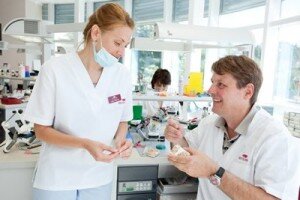To achieve a perfect result, it’s vital that the colour is matched correctly. “For best results, the dental technician should be able to look at the patient’s mouth in person,” says Peter Meier, master dental technician at the Dentaprime Clinic. “Thanks to their experience in the laboratory, they will be able to make a precise judgement about the colour and adapt the dental prosthesis correctly in terms of its colour, shape and structure.” In most cases, dentists are not able to predict the colour with the same degree of precision, while photographs often distort the image. In addition, the communication between dental technician and dentist is also subject to flaws and misunderstandings. Due to the lack of sound, collaborative process between clinic and laboratory, the colour specified by the dentist can often differ significantly from the actual colour of the patient’s teeth.

This can have negative consequences for both the dentist, the dental technician and the patient – in fact, the most frequent reason for needing to remake a dental prosthesis is the incorrect matching of colour. For the patient, the disadvantage is twofold: not only do they have to wait longer for the “right” dental prosthesis, they must also put up with the annoyance of additional appointments, since the dentist often doesn’t realise their error in judgement until the patient returns to the clinic in person. “The mistake usually only becomes apparent when the dentist is able to view the dental prosthesis in direct contrast to the patient’s existing teeth,” says Peter Meier. “And by then, it’s too late. A new prosthesis has to be made.” Considerable additional effort is required from dentists and dental technicians to remake or modify the prosthesis in a way that will be compatible with the patient.
In addition, dental technicians require a diverse range of tools to reconstruct the attractive yet natural-looking white of the teeth. It is important, for example, that they work with the right lighting, since any reflections may distort the colour. “The perception of colour is a subjective, physiological sensory function and can be influenced by a range of external factors,” explains Peter Meier. “For this reason, we must ensure that interfering factors are avoided or neutralised to as great an extent as possible.”
The best way to guarantee precise collaboration between dentists and dental technicians is to be treated in a dental clinic. Everyone involved in the process works under one roof, and the dental technician is able to form an accurate image of the patient’s mouth. They can get to know the patient and allow them to have input into the process.
“Because we have a better understanding of colour matching and more experience in the field than dentists, we are able to guarantee an optimal match,” says Peter Meier. “Everyone is a specialist in their own area. That makes a good team!”
Have a question on this topic, or want to share your personal experience? Leave a comment below – we’ll be happy to get back to you!


